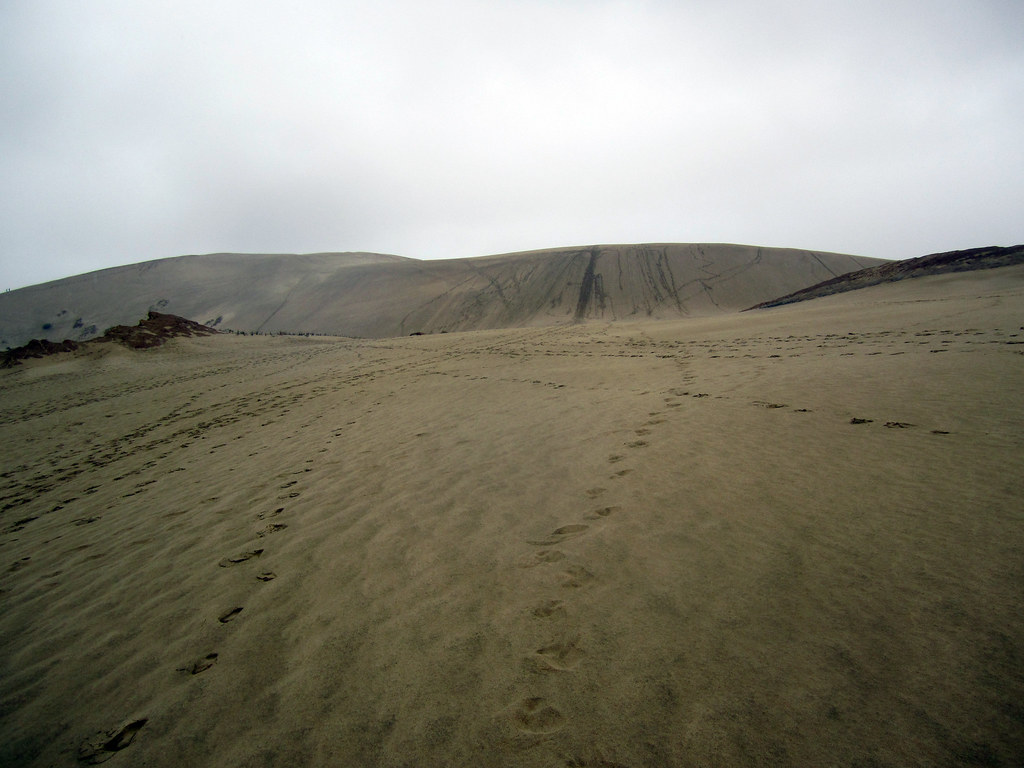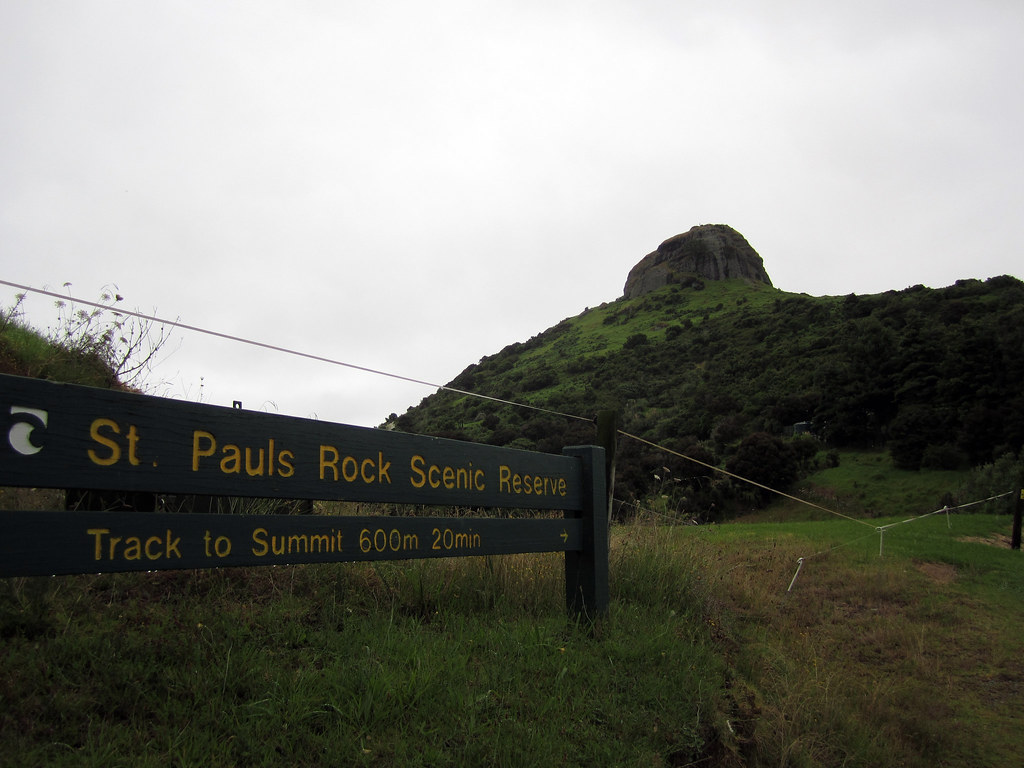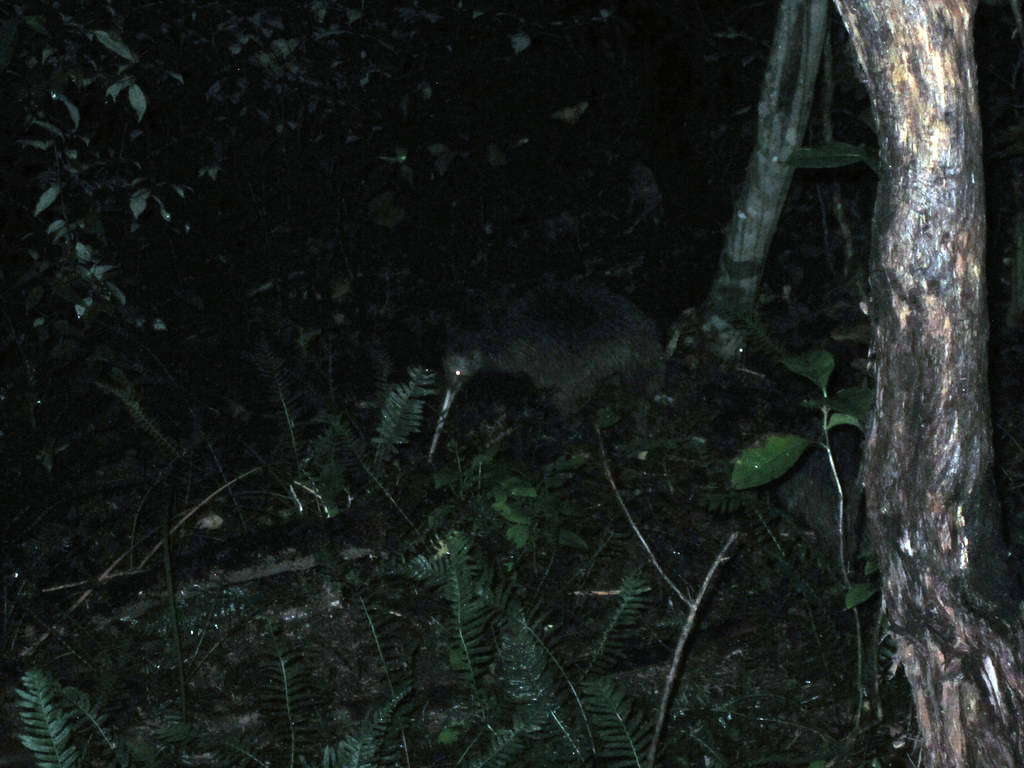After a hellishly adventurous morning of hiking, soaking wet, in the rain out to New Zealand's westernmost point, I wasn't sure how much more adventure I'd be up for for the rest of the day. But then, as I was driving from Cape Reinga to Paihia, where I had accommodation booked that night, I passed the sign for Te Paki Sand Dunes and thought to myself, "I might not ever get the chance to come back this way in my life, so I might as well stop and see it now."
 |
| Coming over the first rise at Te Paki Sand Dunes |
Well, I knew I wasn't going to spend a huge amount of time here, so when I got to the top, I had a nice look around, took some photos of the area, and then starting heading down. But this wasn't just any saunter down the sandy slopes. Oh, no! Growing up going to the beaches, one of my favourite things to do was go dune jumping. Usually this involves finding a nice sturdy tussock of grass near the top of the dune, getting a running start, and then throwing yourself off that tussock into the air and landing on the downslope surface of the dune. If you land on your feet without breaking your legs, it's possible to then use that momentum and run all the way down the rest of the hill. There was no dune grass here, but the sand slope was steep and a good running start was all I needed and with arms windmilling through the air, I ran down in big, leaping steps to the sandy plateau.
Here on the plateau, one of the rock outcrops caught my interest. It was circular from above and looked almost dome-like except that while the middle of the dome and its edges were still in tact, the rest had eroded out by some means of chemical or physical weathering. Up on the dune slope I'd just run down, there were a few other people using their footsteps to make large pictures in the sand. I think the one group of kids must have been from Switzerland since they made a big square with the cross in the middle.
I crossed the sandy plateau and dune-jumped my way back down to the creek and crossed over to my car, brushed off and got back on the road. Not much further down the cape, there was a sign pointing toward "New Zealand's Northernmost Pub" and I thought I should stop in for a bite to eat and charge my phone at the same time. I figured it would be some British-esque pub with a warm fire, carved wood booths, and a generally cozy atmosphere. Boy was I wrong. This place I don't think ever was cozy or welcoming, and while the staff was friendly and accommodating, I didn't want to stay there a moment longer than I needed to and I don't suggest anyone stop here. You will be sorely disappointed!
 |
| The Whangaroa lookout |
I didn't stay long, though, just long enough to get a 360° panoramic shot but then I got back in the car and kept driving. My destination for the night was the Aroha Island Ecological Centre, just east of Kerikeri. I'd read about Aroha Island in the Lonely Planet guide and after reading that they have a few northern brown kiwi birds living on the island, I didn't think I had a choice but to book a camping spot here! Kiwis are exceptionally rare in the wild in New Zealand. In fact, many New Zealanders haven't seen a kiwi in the wild! Since I've been on my "must see all Australian wildlife in the wild" kick, I figured I may as well add kiwis to the list and do my best to see them in their native habitat, too! And Aroha Island was the perfect place for that; they offered nightly tours of the island for an additional charge saying that most tours see a kiwi. But when I checked in, the lovely woman at the Welcome Centre said they weren't doing any tours...but that I could use one of their flashlights and have a map of the island and see if I could see them for myself!
I set up my tent in the last remaining hours of daylight and backed up all of my photos from my hiking adventures at Cape Reinga to my iPad, waiting for darkness to settle in. The woman told me that the kiwis are seen all hours of the night and that they start roaming around 10:30pm. I was told to not make much noise because while kiwis have bad eyesight, they hear very well; I was also told to use the flashlight given to me which had a red filter on it because the kiwis couldn't see that red light, and that any regular flashlight would scare them off for sure. It started raining again, though not too hard, and I figured I'd have to put my rain gear back on if I didn't want to get wet, but that meant I'd be making a lot of noise while walking along the path. The island isn't large and only take about 30 minutes to walk the perimeter, so I set off with the red light and the map.
The woman also mentioned that I would know the kiwis were there long before seeing them because they make a very distinct snuffling noise. Kiwis are different from most birds in that their nostrils are located at the end of their beaks and since they use their beaks to sift through the soil while looking for food, they constantly have to clear their airways and in doing so make a very dry wheezing sound. Well, even with that information, I couldn't hear much more than the rain dripping through the leaves and my rain pants brushing up against each other. I moved so slowly along the path, thinking every noise was a kiwi, that it took me about half an hour just to walk half the island. I started along the other half thinking I was on a wild goose - errr kiwi - chase when I heard it!
 |
| One of the two wild northern brown kiwis I saw on Aroha Island |
Needless to say, at the end of the day, hiking 15 kilometres, climbing a large sand dune, hiking to the top of a rocky lookout, and successfully sighting some wild kiwis, I was exhausted and slept very very well! The next morning, as I was packing up my tent, some very friendly ducks came by to wish me safe travels and to thank me for staying at Aroha Island, insisting that I recommend it to anyone who wants to have wild kiwi adventures while traveling through New Zealand. I told them I surely would!

No comments:
Post a Comment